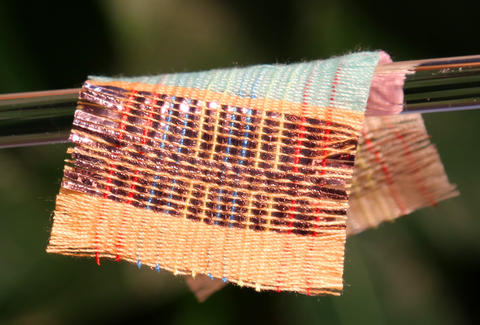Soon You'll Be Able To Charge Your Phone With Your Clothes
Smartphone batteries may be getting ever-so-slightly better every year, and mophie backups have become a convenient stop-gap when you're out of juice on the go, but c'mon, it's nearly 2017 -- shouldn't we be able to conjure electricity from our own bodies at this point?
 Good news, my battery-dependent people: Some intrepid researchers just invented a super-thin, flexible fabric that can generate electricity from light and movement. That means recharging our ubiquitous pocket computers may soon be as simple as slipping on a sweater and going for a walk.
Good news, my battery-dependent people: Some intrepid researchers just invented a super-thin, flexible fabric that can generate electricity from light and movement. That means recharging our ubiquitous pocket computers may soon be as simple as slipping on a sweater and going for a walk.
A team of scientists at the Georgia Institute of Technology has been working on the material for at least two years. It's essentially wool weaved together with special fibers made up of solar cells and "triboelectric nanogenerators" -- aka little things that generate a small amount of electrical energy from the friction produced by slight movements, like rotation or vibration.
In tests that exposed the material to ambient sunlight and wind, it was able to charge a commercial capacitor to two volts in one minute. So while it isn't capable of generating a ton of electricity, feasibly it could continuously power your phone, if not give it a significant recharge, when you're out being active on a sunny day.
The fabric is slightly thick and rough -- more like a poncho or cobija blanket than a T-shirt. Still, it's lightweight and versatile enough to be integrated into goods like tents or backpacks, which means your future camping trips may come equipped with mini-generators to keep you plugged in while you're off the grid.
This development bodes well for the future of integrated wearable technology --imagine being able to track your physical activity or vitals without strapping on some bulky device, and never needing to plug in to recharge. Plus, researchers point out that scaling production of this material wouldn't necessarily be too costly, since they successfully fabricated it without any speciality equipment -- just a traditional weaving machine. Combine this news with the forthcoming rapid-charging phone batteries and computers that only need to be juiced up every few months, and we're well on our way to untethering ourselves from the electrical outlet once and for all.
 Good news, my battery-dependent people: Some intrepid researchers just invented a super-thin, flexible fabric that can generate electricity from light and movement. That means recharging our ubiquitous pocket computers may soon be as simple as slipping on a sweater and going for a walk.
Good news, my battery-dependent people: Some intrepid researchers just invented a super-thin, flexible fabric that can generate electricity from light and movement. That means recharging our ubiquitous pocket computers may soon be as simple as slipping on a sweater and going for a walk.A team of scientists at the Georgia Institute of Technology has been working on the material for at least two years. It's essentially wool weaved together with special fibers made up of solar cells and "triboelectric nanogenerators" -- aka little things that generate a small amount of electrical energy from the friction produced by slight movements, like rotation or vibration.
In tests that exposed the material to ambient sunlight and wind, it was able to charge a commercial capacitor to two volts in one minute. So while it isn't capable of generating a ton of electricity, feasibly it could continuously power your phone, if not give it a significant recharge, when you're out being active on a sunny day.
The fabric is slightly thick and rough -- more like a poncho or cobija blanket than a T-shirt. Still, it's lightweight and versatile enough to be integrated into goods like tents or backpacks, which means your future camping trips may come equipped with mini-generators to keep you plugged in while you're off the grid.
This development bodes well for the future of integrated wearable technology --imagine being able to track your physical activity or vitals without strapping on some bulky device, and never needing to plug in to recharge. Plus, researchers point out that scaling production of this material wouldn't necessarily be too costly, since they successfully fabricated it without any speciality equipment -- just a traditional weaving machine. Combine this news with the forthcoming rapid-charging phone batteries and computers that only need to be juiced up every few months, and we're well on our way to untethering ourselves from the electrical outlet once and for all.

Comments
Post a Comment